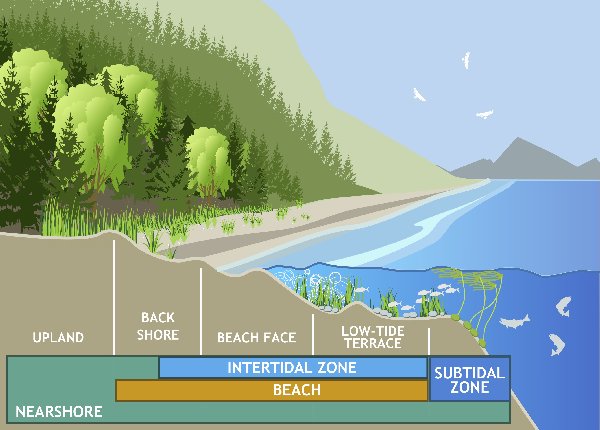Marine Riparian zone of nearshore
The marine riparian is sometimes called the uplands. It consists of the shrubs and trees that provide important services to the nearshore and the fish, animals and birds that live there. These services include:
Like other areas of nature, the native plants provide many services. Invasive plants however can push out these important native plants, and so prevent the nearshore from working as it should.
Shade vital for food chains
The shade provided by shrubs and trees in the marine riparian zone is vital to the survival of Surf Smelt, an important part of several food chains in the nearshore. The Smelt spawn in the upper intertidal and so the eggs are exposed to the hot sun. With shade to keep them cool, the eggs can survive. Without shade from the marine riparian, the eggs can bake in the sun and die.
Insects key to salmon survival
The shrubs and trees that hang over the high tide provide insects to fish in two ways. First are those insects that drop into the water from the trees. Second are those insects that spend time in the cool shade and fly over the water, to be grabbed by the fish. This source of insects has been shown to be vital to the survival of Chinook and Coho salmon, and Cutthroat Trout
Invasive plants spreading in marine riparian
Many people that live along the water introduce plants into the nearshore without realizing it. We know from seeing what has happened in Washington State and other locations that several plants that we grow in our gardens can actually take over estuaries and nearshore ecosystems. When this happens the habitat (food and homes) of several native birds and animals disappears, and the ecosystem can’t work properly. It is important to remove invasive species and re-establish native plants.
How plants are introduced
- Some have a seawall and toss their lawn and garden clippings over into the ocean, thinking it will be taken away. The currents however can carry these plants to other locations where they start themselves.
- Other landowners have gardens planted along the edge of the backshore, or replace the backshore with a garden. Invasive species will spread into the nearshore by rhizome, seeds, or clippings.
Plants to remove
MVIHES mapped the vegetation in the Englishman River Estuary and found several key species that need to be managed. We also created an initial visual tool re health of the marine riparian. The list below is based on this mapping work.
There are many invasive plants on the coast and other sources will provide detailed information.
Plants to remove here include:
- English Ivy
- Herb Robert
- Yellow Laminarium
- Scotch Broom
- Periwinkle
What is a Nearshore Ecosystem?
The nearshore includes the area from the deepest part of the photic zone (layers of water exposed to sunlight) landward to the top of shoreline bluffs, or in estuaries upstream to the head of tidal influence.
The Nearshore includes four basic zones.
- the subtidal which is always under water and where vegetation like eelgrass and kelp grow
- the intertidal zone which is underwater when the tide is in. When the tide is low this zone is exposed
- the backshore zone, beyond the reach of normal waves and tides. It includes native grasses and other perennials, logs and sometimes boulders, and is also often the site of dunes and back-barrier wetlands
- the upland area that consists of shrubs and trees. This area is often also called the marine riparian.
Why the nearshore is important
On different types of beaches, these zones will look different. For example a sandy beach will have a low, flat and sandy intertidal zone, but a rocky beach will have a rocky intertidal. Much of the information we will focus on will apply to the sandy beaches as they are prevalent in this area.
The nearshore ecosystem is complex. Because of certain habitats, we will find certain species at the low end of food chains, which then determine the animals, birds and fish that are further up the food chains. There are often connections between food chains.
In order to understand and manage the nearshore, we need to simplify the picture. For this reason we determine the health of the nearshore ecosystem by mapping and monitoring specific parts of the ecosystem, called indicators. We use five indicators of nearshore health
Together these zones work to stabilize our shorelines, provide important habitat for many animals, fish and birds. The nearshore also gives us many ecosystem services which include clean air and water; storm and flood management; adaptation to climate change; food sources including a fishing industry; tourism industry activities like whale watching, birding, kayaking, swimming, walking or playing on warm, safe beaches; and a general quality of life.
Five indicators of nearshore health
The nearshore ecosystem is complicated and so in order to determine if it is healthy or not, managers must choose some indicators to measure, that together, can tell them if the nearshore is working or not. We will use the same five nearshore indicators as those used in Puget Sound:
